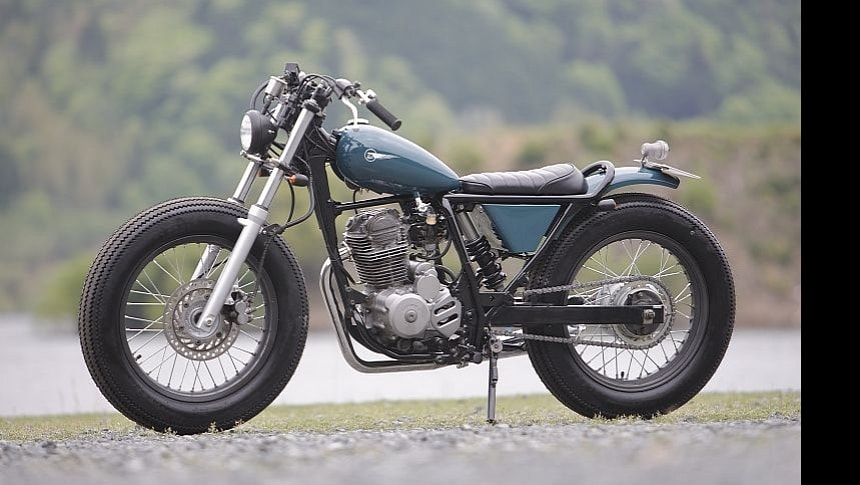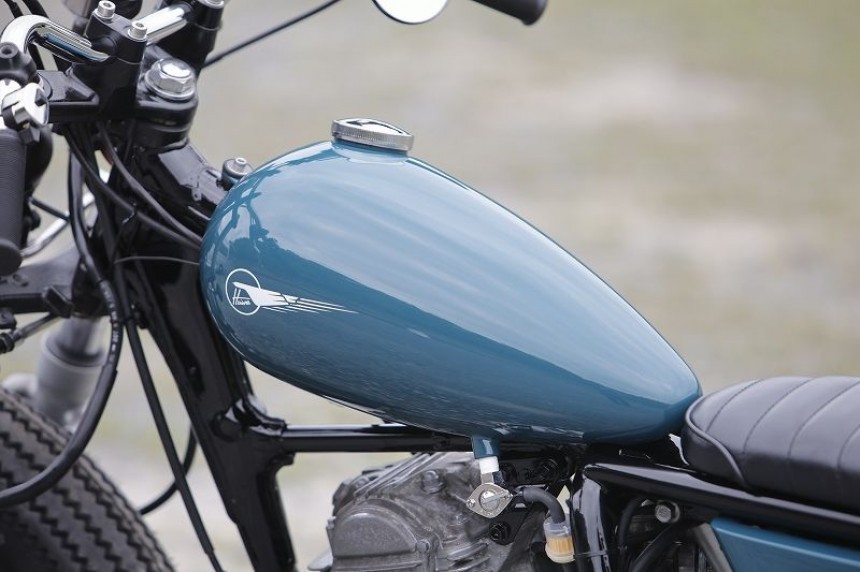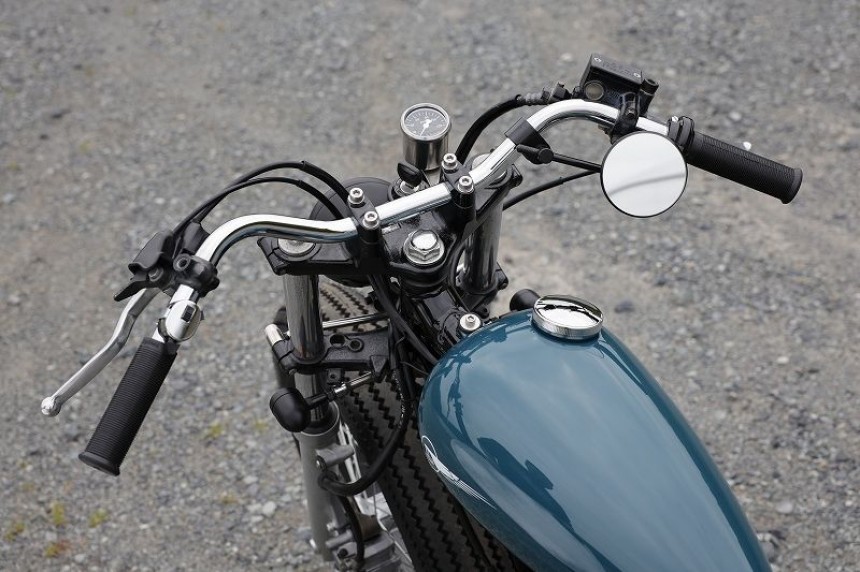Known to the wider public as Heiwa Motorcycle, Kengo Kimura is among the finest bike-modding gurus that Japan has to offer. That’s a bold statement for us to make, of course, but Kengo has a ton of top-tier projects under his belt to back it up. We’ve covered many of them in the past, and the one we’ll be looking at today is no less impressive than those previously featured across the web.
The bike in question is styled as an old-school street tracker with tiny pinches of bobber charm here and there. As his starting point for this conversion, Kimura-san used a model solely available on the Japanese market – the Honda FTR 223. Nowadays, the FTR name is obviously associated with Indian, but Honda was the first manufacturer to have it in their lineup many years ago.
Heiwa’s donor was released in the year 2000, and it was still in relatively decent shape upon arrival at the shop. After placing it on his workbench and discarding all the factory bodywork, Kengo kicked things off with some structural modifications to get the ball rolling. He chopped off the rearmost section of the subframe, replacing it with a looped tube that bends upwards gracefully.
With this structure welded on, the rest of the frame was cleaned up and then painted black from head to toe. Some heavy lifting also took place in the unsprung sector, where we now find a fresh set of 18-inch rims enveloped in beefy, retro-looking tires. The FTR 223’s original suspension hardware has been retained, but it got lowered by 50 millimeters (two inches) at both ends.
All the bits and pieces were then treated to a much-needed scrub, and the shock spring was painted black just like the frame. With the brakes refurbished and a rolling chassis pieced together, Heiwa’s mastermind turned his attention to the bodywork. He fabricated all the new components from scratch, with the centerpiece being a gorgeous fuel tank fashioned like the peanut-style items found on many choppers.
Its compact design makes the footwear look even chunkier, moving most of the visual mass down low. The gas tank fronts a stylish black leather seat made in-house, while a custom rear fender can be spotted further back. It carries the license plate bracket and a circular aftermarket taillight, but the rear turn signals are both attached to the subframe tubing. We’re not done talking about the bodywork just yet, though.
Right beneath the saddle, one may see what looks like a triangular oil tank. It is in fact a handmade storage box housing the motorcycle’s electronic paraphernalia, and Kengo also came up with a removable front fender that's not pictured here. The entire outfit was ultimately finished in a dark shade of teal, along with tank graphics depicting Heiwa’s logo.
There’s quite a lot to take in at the front end, too. Kengo used tailor-made mounting hardware to fit a small Bates-style headlamp. It measures 4.5 inches in diameter and is accompanied by a pair of LED blinkers similar to those found at the rear. The cockpit area is minimalistic and infused with a nice bit of chopper flair, mostly due to the bespoke handlebar built at Heiwa’s headquarters.
It wears a layer of chrome plating and snazzy aftermarket grips, as well as a single underslung mirror on the right-hand side. The only bit of instrumentation you’ll find on this custom FTR is a small speedometer encased in an aluminum housing. Deciding to leave the single-cylinder engine unchanged on the inside, master Kimura kept the powertrain mods limited to the intake and exhaust.
For the latter, he fashioned a stunning setup out of stainless-steel piping. The exhaust header runs into a reverse megaphone silencer on the right, and the whole arrangement has been chrome-plated for durability and visual effect. On the intake side of things, there is a premium aftermarket pod filter keeping the airflow nice and clean. The cherry on top of the cake (and finishing touch) is a plain filler cap offset to the right.
Given his extensive know-how and practical experience, Kengo Kimura of Heiwa Motorcycle sailed through this build without breaking much of a sweat. At the end of the day, this sort of conversion is a straightforward affair for a craftsman of his caliber, but it does demonstrate how a genuine head-turner can be put together on a tight budget.
Sure, you may not have an easy time finding an FTR 223 in Western markets, yet this particular blueprint can easily be applied to other donors. For instance, we can vividly picture a Yamaha SR400 getting a similar custom treatment, and that’s just one of many examples. Without breaking the bank or overcomplicating anything, Kengo managed to completely transform the factory tracker’s outdated appearance into something truly timeless.
Heiwa’s donor was released in the year 2000, and it was still in relatively decent shape upon arrival at the shop. After placing it on his workbench and discarding all the factory bodywork, Kengo kicked things off with some structural modifications to get the ball rolling. He chopped off the rearmost section of the subframe, replacing it with a looped tube that bends upwards gracefully.
With this structure welded on, the rest of the frame was cleaned up and then painted black from head to toe. Some heavy lifting also took place in the unsprung sector, where we now find a fresh set of 18-inch rims enveloped in beefy, retro-looking tires. The FTR 223’s original suspension hardware has been retained, but it got lowered by 50 millimeters (two inches) at both ends.
All the bits and pieces were then treated to a much-needed scrub, and the shock spring was painted black just like the frame. With the brakes refurbished and a rolling chassis pieced together, Heiwa’s mastermind turned his attention to the bodywork. He fabricated all the new components from scratch, with the centerpiece being a gorgeous fuel tank fashioned like the peanut-style items found on many choppers.
Right beneath the saddle, one may see what looks like a triangular oil tank. It is in fact a handmade storage box housing the motorcycle’s electronic paraphernalia, and Kengo also came up with a removable front fender that's not pictured here. The entire outfit was ultimately finished in a dark shade of teal, along with tank graphics depicting Heiwa’s logo.
There’s quite a lot to take in at the front end, too. Kengo used tailor-made mounting hardware to fit a small Bates-style headlamp. It measures 4.5 inches in diameter and is accompanied by a pair of LED blinkers similar to those found at the rear. The cockpit area is minimalistic and infused with a nice bit of chopper flair, mostly due to the bespoke handlebar built at Heiwa’s headquarters.
For the latter, he fashioned a stunning setup out of stainless-steel piping. The exhaust header runs into a reverse megaphone silencer on the right, and the whole arrangement has been chrome-plated for durability and visual effect. On the intake side of things, there is a premium aftermarket pod filter keeping the airflow nice and clean. The cherry on top of the cake (and finishing touch) is a plain filler cap offset to the right.
Given his extensive know-how and practical experience, Kengo Kimura of Heiwa Motorcycle sailed through this build without breaking much of a sweat. At the end of the day, this sort of conversion is a straightforward affair for a craftsman of his caliber, but it does demonstrate how a genuine head-turner can be put together on a tight budget.
Sure, you may not have an easy time finding an FTR 223 in Western markets, yet this particular blueprint can easily be applied to other donors. For instance, we can vividly picture a Yamaha SR400 getting a similar custom treatment, and that’s just one of many examples. Without breaking the bank or overcomplicating anything, Kengo managed to completely transform the factory tracker’s outdated appearance into something truly timeless.



